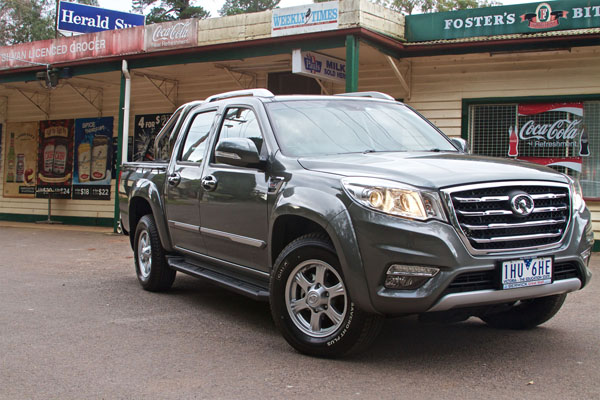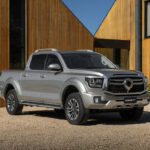 Few would deny how far utility vehicles have come in the past two decades. Any doubts can be quickly dismissed by getting behind the wheel of the latest Great Wall Motors Steed. The Dual Cab is so last century.
Few would deny how far utility vehicles have come in the past two decades. Any doubts can be quickly dismissed by getting behind the wheel of the latest Great Wall Motors Steed. The Dual Cab is so last century.
While there are some positives about the latest version of the pickup – toughness, reliability, and most of all, price (from $24,990 driveaway) – there are question marks against the Steed’s safety.
Don’t just take my word for it. Here’s what independent vehicle safety advocate, the Australasian New Car Assessment Program, says after awarding the Steed a lowly two-star rating;
“Despite claims from the vehicle brand that the Chinese dual cab is ‘all-new’ and offers ‘outstanding levels of performance, value, safety and comfort,’ the underpinnings of the Steed differ little to that of the previous generation dual cab ute which carried the V240 model name.
“This is a disappointing result for consumers and the brand,” ANCAP’s CEO, James Goodwin said. “While the Steed is equipped with six airbags and electronic stability control, features which were not offered on the previous model, there has been little change to the vehicle’s structure to improve the safety of the passenger cabin.”
ANCAP is urging consumers in the market for a new car to be wary of such claims, with independent testing key to understanding the true safety performance of a vehicle.
Excessive footwell deformation, separation of footwell panels and pedal displacement was observed in the frontal offset crash test. Steering column components were a potential source of knee injury for the driver, and dash components were a potential injury source for both the driver and front passenger. Protection of the driver and front passenger from whiplash injuries was also marginal.
The Steed is not fitted with top tether child restraint anchorages and is therefore not suitable for transporting young children.
With three models available, in two and four-wheel drive with petrol or diesel power, needless to say, the test vehicle, a Steed Dual Cab Diesel 4×4 priced at $29,990 driveaway, was not given a real life safety workout, but driven with ANCAP’s words ringing in the ears and without young passengers.
STYLING
The Steed is 305mm longer than the previous Great Wall ute and is 30mm higher. The rear tub is now 155mm longer, while a new front grille design adds a further 150mm to the front of the vehicle.
An undoubtedly tough looking new exterior is dominated by a new large chrome grille, integrated with new headlamps, daytime running lamps and chrome highlights.
Standard features include side steps, a stainless steel sports bar, mirror-mounted indicators and 16-inch alloy wheels.
INTERIOR
The cabin is surprisingly well kitted out for comfort and convenience with standard features including heated seats, six-way powered driver’s seat, cruise control with steering wheel controls, a leather-wrapped steering wheel, stainless steel scuff plates and climate control air-conditioning.
INFOTAINMENT
Bluetooth phone and audio streaming are on tap but as there is no colour screen, satellite navigation is only a dream.
ENGINES / TRANSMISSIONS
The Steed offers the choice of two powertrains – a fuel-injected 2.4-litre petrol engine or a 2.0-litre common-rail turbo-diesel.
The latter (the test vehicle) produces 110 kW of power at 4000 rpm and 310 Nm of torque from a low 1800 to 2800 revs.
Matched to a six-speed manual transmission, the Euro V-compliant turbo-diesel Steed has a claimed fuel consumption of 9 litres per 100km on the combined urban / highway cycle making for a range of more than 800 kilometres. The turbo-diesel is available in 4×2 and 4×4 configuration.
SAFETY
The Steed comes standard with six airbags, including full-length side curtain airbags, as well as electronic stability program, including ABS anti-locking brakes with electronic brake-force distribution, brake assist, and hill-start assist.
The vehicle also comes standard with tyre pressure monitoring, which is mandatory on passenger vehicles sold in the USA and Europe. Safety experts believe incorrectly inflated tyres are responsible for many accidents and running correct pressures reduces tyre damage, extends tyre life and ensures optimum fuel economy.
DRIVING
Great Wall says the turbo-diesel engine’s torque delivery has been tuned to deliver greater responsiveness, faster torque delivery and better acceleration feel.
The test vehicle came up short on all of the above, being ponderous on take-off and far from responsive to steering input. Fuel consumption worked out at 10 litres per 100 kilometres in the suburbs and a tad under seven on the highway.
Double wishbone independent front suspension is backed up by a leaf-sprung rear axle and is made for tough jobs. Considering this, the ride was passable at slow speeds but became less so as speed increased – no grand tourer.
There’s no doubt the Steed would be attractive as a workhorse with a payload of 1010 kg and four heavy-duty tie-down points inside the lined tub. A braked towing capacity of 2000 kg comes standard and could adequately cover most jobs.
SUMMING UP
With a company motto of ‘improving little by little every day’, GWM has been the brand with the best-selling ute in China for the past 18 years. There’s still much room for improvement.
AT A GLANCE
MODEL RANGE
Steed Dual Cab Petrol 4×2 – $24,990 driveaway
Steed Dual Cab Diesel 4×2 – $26,990 driveaway
Steed Dual Cab Diesel 4×4 – $29,990 driveaway
SPECIFICATIONS (Great Wall Steed 2.0-litre direct injection turbo-diesel Dual Cab Ute)
ENGINE:
Configuration: Four cylinders in line
Maximum Power: 110 kW @ 4000 rpm
Maximum Torque: 310 Nm @ 1800-2800 rpm
Fuel Type: Diesel
DRIVELINE: Six-speed manual. Intelligent 4WD with BorgWarner transfer case
DIMENSIONS, WEIGHT AND CAPACITIES:
Length: 5345 mm
Width: 1850 mm
Height: 1768 mm
Gross Vehicle Mass: 3920 kg
BRAKES:
Front: Ventilated disc
Rear: Solid disc
STANDARD WARRANTY:
Three years / 100,000 km












